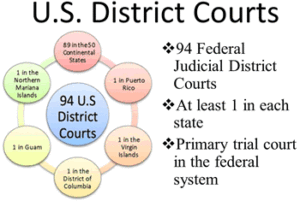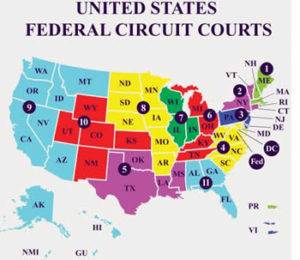Circuit Courts vs. District Courts
In addition to the United States Supreme Court, the federal judiciary is comprised of District Courts and Circuit Courts (or Federal courts of appeals).
 Federal courts are courts of limited jurisdiction, meaning they usually only hear cases authorized by the United States Constitution or federal statutes. There are exemptions to this such as cases entirely based on state law being brought to federal court under “diversity jurisdiction.” Diversity jurisdiction allows a plaintiff of one state to file a lawsuit in federal court when the defendant is located in a different state. In such cases, the “amount in controversy” must be more than $75,000. Criminal cases may not be brought under diversity jurisdiction.
Federal courts are courts of limited jurisdiction, meaning they usually only hear cases authorized by the United States Constitution or federal statutes. There are exemptions to this such as cases entirely based on state law being brought to federal court under “diversity jurisdiction.” Diversity jurisdiction allows a plaintiff of one state to file a lawsuit in federal court when the defendant is located in a different state. In such cases, the “amount in controversy” must be more than $75,000. Criminal cases may not be brought under diversity jurisdiction.
District Courts are “lower” and have the responsibility for holding trials. Litigation goes first to the District Court level. Circuit Courts are appellate courts that do not hold trials but are for appeals for cases decided by the lower court. Several different district courts may fall under the same appellate (circuit) court. District courts hear both civil and criminal cases.
In a District Court case, only one judge is assigned to a case. There are 94 District Courts throughout the US and the associated territories, including Guam, the Virgin Islands, Puerto Rico, the District of Columbia and the Northern Mariana Islands.There are over 670 district court judges nationwide. Each federal district also has a bankruptcy court for those proceedings. Additionally, some courts have nationwide jurisdiction for issues such as tax (United States Tax Court), claims against the federal government (United States Court of Federal Claims), and international trade (United States Court of International Trade).

The Circuit Court System is 13 appellate courts that are called the U.S. Courts of Appeals. Many of the Circuit Court systems are spread over many buildings and cities. Circuit Court judges rotate through each of these regions in the “circuit.” Each case in circuit court has a panel of three judges. Though it’s rare, the entire circuit court may consider certain appeals in a process called an “en banc hearing.” The Ninth Circuit has a different process for en banc than the rest of the circuits.
Each Circuit Court has multiple judges, ranging from six on the First Circuit to twenty-nine on the Ninth Circuit. Circuit court judges are appointed for life by the president and confirmed by the Senate.
Beyond the Federal Circuit, a few courts have been established to deal with appeals on specific subjects such as veterans claims (United States Court of Appeals for Veterans Claims) and military matters (United States Court of Appeals for the Armed Forces).
